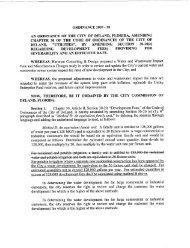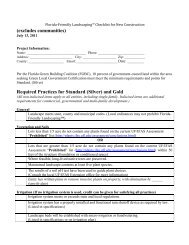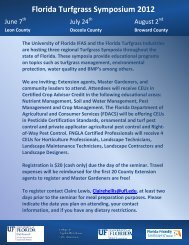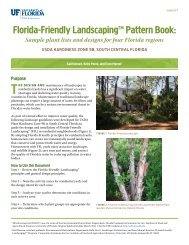A Guide to Florida-Friendly Landscaping A Guide to Florida-Fr ...
A Guide to Florida-Friendly Landscaping A Guide to Florida-Fr ...
A Guide to Florida-Friendly Landscaping A Guide to Florida-Fr ...
Create successful ePaper yourself
Turn your PDF publications into a flip-book with our unique Google optimized e-Paper software.
REDUCE STORMWATER RUNOFF<br />
Since the formation of the EPA and the passage of the Clean Water Act, great<br />
strides have been made <strong>to</strong>ward maintaining and res<strong>to</strong>ring water quality<br />
throughout the United States. This has been accomplished through regulating<br />
point sources of pollution, such as smokestacks and sewage discharge. But a<br />
more diffuse source of pollution — nonpoint source (NPS) pollution —<br />
threatens <strong>Florida</strong>’s ecosystems.<br />
Many of <strong>Florida</strong>’s water resources are especially susceptible <strong>to</strong> pollution<br />
because of our unique geology and climate. Floridians obtain most of their<br />
drinking water from ground water supplies. Ground water often lies near the<br />
surface, covered by porous limes<strong>to</strong>ne and sandy soils, both of which allow<br />
water <strong>to</strong> infiltrate rapidly. Dissolved pollutants reach ground water through a<br />
process called leaching. These impurities affect the quality of our drinking<br />
water. Heavy rainfall, typical during <strong>Florida</strong>’s rainy season, is a major cause of<br />
leaching and s<strong>to</strong>rmwater runoff. Surface waters in <strong>Florida</strong> such as lakes,<br />
streams, rivers and estuaries are very sensitive <strong>to</strong> even small amounts of<br />
pollution.<br />
FYN Glossary Box<br />
Point source pollution: water pollution that results from<br />
water discharges in<strong>to</strong> receiving waters from easily identifiable<br />
points; common point sources of pollution are discharges from<br />
fac<strong>to</strong>ries and municipal sewage treatment plants<br />
Nonpoint source (NPS) pollution: NPS pollution cannot be<br />
pinpointed <strong>to</strong> a single source. Over time, pollutants from our<br />
everyday activities accumulate on the land. Examples of NPS<br />
pollutants include gasoline, fertilizer, pesticides and even soil. NPS<br />
pollution is a problem when rainfall or heavy irrigation carries<br />
sediments and dissolved chemicals <strong>to</strong> waterways in s<strong>to</strong>rmwater<br />
runoff and by leaching or percolating through soil<br />
S<strong>to</strong>rmwater runoff: water that runs off impervious or watersaturated<br />
surfaces, transporting sediments and dissolved<br />
chemicals in<strong>to</strong> nearby waters<br />
DEP NPS Page:<br />
92














